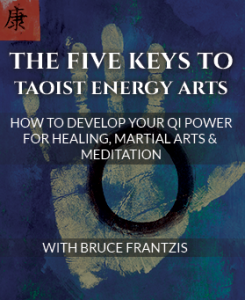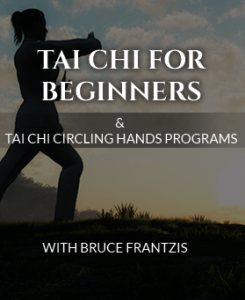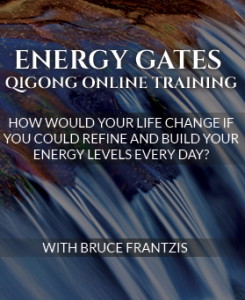Richard: In the West, we think of meditation as somebody sitting down in lotus position . . .
Bruce: Right, “contemplating the navel” . . .
Richard: Right, with the carrot in your ear or the light behind your head . . . In the east . . . Can you just explain what moving meditation is, and what are some of . . .
Bruce: Should we start with just “what is meditation in the East”?
Richard: Yeah, you can do that.
What is Meditation in the East?
Bruce: Okay, first of all, this idea of someone just sitting down and contemplating their navel, or as you so quaintly put it, having a carrot in your ear and a lampshade on your head . . . meditation is looked at as having several levels or degrees. So, we have the term ‘meditation’, but it doesn’t take into account the degrees and levels of it. It’s like saying an open statement like ‘education’. So of course, when you use that term, going to kindergarten is the same as getting a PhD or your post doctoral. But that’s not really true, even though they are all ‘education’.
So the first thing you have to look at is that, in the East, meditation . . . they don’t confuse the physical format within which you do meditation with the meditation itself. So, for example, in Taoism, and in many schools of Buddhism, and in Hinduism as well, you have that all forms of meditation are done sitting. That’s the one where this idea of ‘navel-gazing’, or someone sitting on top of the mountain, that’s the popular one, came about. But you also have moving forms of meditation, such as Tai Chi or qigong. But then, so are the walks that they take in Vipassana, and in Zen, after they sit. So are many of the classic moving Hatha yoga practices of walking for fifty miles at a time. So there is moving in many ways. There are many ways you can move your body.
There is also standing, where you stand still. I mean, you can see processes where meditation was used with standing. You can go back to the Jains in India, they had ones where they were standing. The Taoists had ones where they were standing. The Buddhists have standing meditations. The Hindus have standing meditations. Taoists do a lot more with standing meditations than most. I think that’s a very fair statement. But there are all forms of standing meditations that exist.
Now you have lying down, where you meditate lying down, which is probably one of the hardest ones, because most people cannot keep a very still mind when they’re lying down, because they fall asleep. They’re not able to keep that level of presence of mind to meditate while they’re lying down. But if you take that, there are lots of lying down meditations in Buddhism. I’m not talking about dream yogas. That’s different, that’s when you were asleep. I’m talking about being awake and lying down. There is a very famous temple in Taiwan which has “the reclining Buddha,” and the Buddha is lying down. So there are things like that. But there have been lots of forms of lying down practices in every form of meditation that have gone as far back as the beginning of time.
Then there is the other aspect, which are the interactive meditations. So how do you do anything that you might do sitting, where you’re sitting on a mountaintop or in a cave or whatever the fantasy is you’re going to do, how do you actually maintain that same space inside of you, if your heart and your mind, while you are at the same time interacting with somebody? Now “interacting” can be something as . . . sex can be interactive, but so can talking, so can farming—where you’re interacting with plants and nature. So, it can be you hanging out with your cat or your dog. Painting. Anything where you are interacting with something. You can be a painter, a writer. Whether it’s a typewriter, whether it’s a canvas, this is an interaction. But the thing that it all has in common is that your mind, your spirit, hasn’t gone away. So this is about the physical ways in which meditation can occur.
Then you start going into meditation. The first level of meditation is just the ability to have the mind be able to focus without jumping around like a bunny rabbit all over the place. It’s done through mantras, people do it with prayer . . . all sorts of things. For example, if a person is praying to God, but their mind is really on fifteen other things, are they really praying? Or is their mind steady? So you have steadiness.
Then you have this . . . Okay, now you’re going to apply your meditation toward what’s inside of you. Well, the next very basic level of meditation is essentially meditation that reduces stress. Doing mantras can reduce stress, doing visualizations can . . . and it isn’t that stress was made up by the West. Cavemen started having stress the first time a saber-toothed tiger decided to come in, or they weren’t sure if they were going to be able to get enough food to last through the winter. Of course, it’s worse now with the level of mental stress, because there is simply so many individual stressful actions a person is going through per hour or per minute.
So now you have this factor of stress. And when it comes to stress, now you’re talking about people finding any kind of peace of mind. Because peace of mind is the opposite of being stressed out. And that is the most common way that most stress is presented in the West. Meditation can make your heartbeat go down, it will decrease your blood pressure, it will improve your immune system, you can go to sleep at night, you will stop hating yourself, etc etc. But all of these things are essentially about reducing stress, which could happen lots of ways. It could just be making you feel a lot better. That can get rid of the stress. Or it could be something that counters the effect of the stress. So fine.
And again, any of the five basic modes of meditation, standing, sitting, moving, lying down, and interacting can all be done to do this.
Then you go to the next level. And the next level is starting to begin to answer the question of “who am I?” and “what am I here for?” Or, another way of putting it, is that . . . ‘Okay, I’m aware of what I am at the surface level of my mind and my body. Well, really, is that it? Is there more to it?’ So, okay, then you need to find out who you are. You need to start finding out what’s at that kind of a depth.
Then the next level of meditation says, you know, on this road to finding out who you are, you have a problem, you can just become an egomaniac, and just wants to know what my personality and my thoughts are. But let’s look at something else. Are you, essentially, okay, really and truly okay with being alive and on this earth, and going through all the nonsense trials and tribulations life can throw at you? I mean, the hardest things in life are not dealing with things when they are great, but dealing with things when they aren’t. And that’s going on all the time in a million different ways. So, can you get a mind that is actually able to deal with all of that? And there all kinds of techniques and methods that will help you to arrive at that. The Buddhists, for example, call one part of it ‘samsara’, “The world,” the crap of the world. The Taoists call it ‘red dust’, the grief of the world.
But then you start going to the next thing, and the next levels of meditation that come about are about, okay, what about when you die? Do you wish to be integrated enough that when you die you go to a good place rather than a bad place? Because if someone says “nothing happens after death”, then clearly, this degree of meditation is something they aren’t going to be interested in. But that doesn’t mean it doesn’t exist.
So then, if it goes past that, and you really want to pass the life/death barrier into finding something that is permanent inside of you, that is not governed by any external circumstance you’re in, anybody you’ll meet, anything that happens, but you’re looking for that which is stable and permanent . . . I mean, Christians might start throwing words like ‘God’ around, or Easterners might start throwing words like ‘enlightenment,’ or ‘awakening,’ or this or that . . . but essentially, they’re talking about arriving at a place that’s, first, not only knowing who you are, but second, you find out what is permanent that goes beyond you. And that’s when you start coming into terms like “enlightenment”, or “emptiness”, or the ability to universally open up your heart. Which is quite different than just being nice for a while, because being a good person doesn’t mean your heart is open. It just means that at least it’s not closed down all the way.
So I would say these are very distinct degrees of meditation. And depending upon what group you’re talking to, that’s what they call ‘meditation.’ “You get rid of stress, that’s meditation”. Well, yeah . . . but then so is a whole lot of other things. So qigong, which doesn’t have to get rid of the emotional stuff that’s ripping you apart, or the mental stuff that rips you apart . . . there are all of these types of things and there are all of these different degrees. And they all use the same word: Meditation.






0 Comments